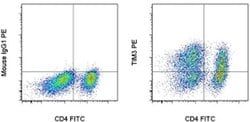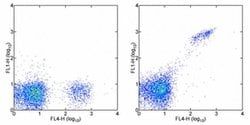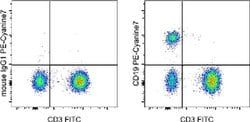CD366 (TIM3) Monoclonal Antibody (F38-2E2), PE, eBioscience™, Invitrogen™
Manufacturer: Fischer Scientific
Select a Size
| Pack Size | SKU | Availability | Price |
|---|---|---|---|
| Each of 1 | 50-112-9014-Each-of-1 | In Stock | ₹ 13,528.00 |
50-112-9014 - Each of 1
In Stock
Quantity
1
Base Price: ₹ 13,528.00
GST (18%): ₹ 2,435.04
Total Price: ₹ 15,963.04
Antigen
CD366 (TIM3)
Classification
Monoclonal
Concentration
5 μL/Test
Formulation
PBS with 0.2% BSA and 0.09% sodium azide; pH 7.2
Gene Accession No.
Q8TDQ0
Gene Symbols
Havcr2
Purification Method
Affinity chromatography
Regulatory Status
RUO
Gene ID (Entrez)
84868
Content And Storage
4° C, store in dark, DO NOT FREEZE!
Form
Liquid
Applications
Flow Cytometry
Clone
F38-2E2
Conjugate
PE
Gene
Havcr2
Gene Alias
CD366; FLJ14428; Havcr2; HAVcr-2; Hepatitis A virus cellular receptor 2; hepatitis A virus cellular receptor 2 homolog; kidney injury molecule-3; KIM-3; sCD366; soluble CD366; soluble TIM 3; T cell immunoglobulin mucin 3; T cell immunoglobulin mucin-3; T-cell immunoglobulin and mucin domain containing 3; T-cell immunoglobulin and mucin domain-containing protein 3; T-cell immunoglobulin mucin family member 3; T-cell immunoglobulin mucin receptor 3; T-cell membrane protein 3; Tim3; TIM-3; TIMD3; TIMD-3
Host Species
Mouse
Quantity
25 Tests
Primary or Secondary
Primary
Target Species
Human
Product Type
Antibody
Isotype
IgG1 κ
Description
- Description: This F38-2E2 monoclonal antibody reacts with human CD366, also known as T cell immunoglobulin and mucin domain-containing protein 3 (TIM3) or HAVCR2
- This cell surface receptor is expressed on activated CD4+ T cell subsets (e.g
- Th1, Th17, and Treg), CD8+ T cells, monocytes, dendritic cells, and mast cells
- Due to alternative splicing, CD366 exists as membrane-bound and soluble forms
- Galectin-9 has been identified as the ligand for CD366
- In humans, this receptor negatively regulates CD4+ T cells, influencing the secretion of some Th1- and Th17-related cytokines
- CD366 has also been implicated in tolerance, autoimmune disease (e.g
- multiple sclerosis), and HIV infection
- Applications Reported: This F38-2E2 antibody has been reported for use in flow cytometric analysis
- Applications Tested: This F38-2E2 antibody has been pre-titrated and tested by flow cytometric analysis of stimulated normal human peripheral blood cells
- This can be used at 5 μL (0.125 μg) per test
- A test is defined as the amount (μg) of antibody that will stain a cell sample in a final volume of 100 μL
- Cell number should be determined empirically but can range from 10^5 to 10^8 cells/test
- Excitation: 488-561 nm; Emission: 578 nm; Laser: Blue Laser, Green Laser, Yellow-Green Laser
- Filtration: 0.2 μm post-manufacturing filtered
- TIM3 (Hepatitis A virus cellular receptor 2, HAVCR2, T-cell immunoglobulin, mucin-dmain containing-3) is a 281 amino acid long, Type-1 Th1- specific cell surface glycoprotein expressed on terminally differentiated CD4+Th1 and CD8+Tc1 cells
- TIM3 consists of an IgV-like domain, a mucin-like domain in the extracellular region, and a conserved Tyrosine phosphorylation motif in the cytoplasmic region
- TIM3 is involved in macrophage activation and induction of autoimmune diseases
- Further, TIM3 down-regulates aggressive Th1-mediated immune responses and facilitates in the development of immune tolerance
- Pathological significance of TIM3 has been attributed to Experimental autoimmune encephalomyelitis (EAE), a Th-1 dependent autoimmune disease, and also enhances the severity of experimental autoimmune encephalomyelitis in mice.



